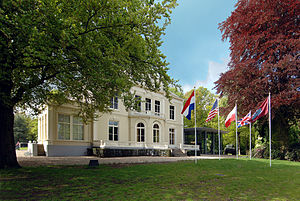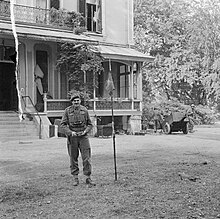Airborne Museum Hartenstein
 Airborne Museum 'Hartenstein' |
|
| Data | |
|---|---|
| place | Oosterbeek |
| opening | 1949 |
| Website | |
The Airborne Museum Hartenstein is a museum in Oosterbeek ( Netherlands ) about the history of the Battle of Arnhem in September 1944. This place, which was the headquarters of the British troops during the fighting, shows a comprehensive collection of authentic weapons, pieces of equipment, clothing, photos Interviews and videos. In addition to this collection, the museum also contains the award-winning Airborne Experience , during which visitors can follow in the soldiers' footsteps. In doing so, one does not only limit oneself to conveying the story from the perspective of the Allies , but also exposes the side of the German soldiers and the civilian population.
prehistory
The building in which the museum has been located since 1978 has a long history. Het Rode Hert , an inn on the Utrechtseweg in Oosterbeek, has been spoken of since 1728 . In 1779 this inn and the adjacent land was bought by J. van der Sluys, a lawyer from the Gelderland court. The hostel was demolished and a mansion with outbuildings was built in the same place. With this renovation, the mansion also got a new name: Hartenstein . After the death of Mr. van der Sluys, Hartenstein came into the hands of various other owners. Since around 1865 the villa has been in its layout and appearance as it is today. In addition, a coach house was built, which today houses the “Hartenstein @ Laurie” restaurant. In 1905 two glass verandas were added. Ultimately, the municipality of Renkum decided in 1942, when they came into possession of the property, to convert the building into a hotel. It played an important role for British paratroopers during World War II .
Operation Market Garden and the Battle of Arnhem

After the invasion of Normandy in June 1944, the Allied troops made a rapid advance towards Germany. The advance was so rapid that the troops were unable to keep up with supplies and a front formed in Belgium and France. In order to bypass the Siegfried Line, Field Marshal Montgomery developed a plan that provided that the Allied troops would have to conquer various bridges in the Netherlands between Eindhoven and Arnhem. With this it was hoped to create a way to penetrate into the Ruhr area and thus Germany. The operation lasted from September 17th until the morning of September 26th. The operation failed due to various misjudgments and deficiencies in the equipment, especially in the telecommunications system.
More than 10,000 Allied airborne troops landed in the area around Arnhem . The most important goal was to capture the traffic bridge over the Rhine in Arnhem and to defend it against German troops until the ground troops can free the airborne troops. Colonel John Frost reached the bridge with the second battalion and was involved in heavy fighting for several days. However, most of the Airborne troops could not reach the bridge, which meant that General Roy Urquhart was forced to set up his headquarters in the Hotel Hartenstein . There was heavy fighting in and around this area, with many dead and wounded on both sides. On Thursday, September 21st, the troops had to give up the fight at the traffic bridge. It was not until September 26th, when the remaining Allied troops withdrew across the Rhine, that the Hotel Hartenstein was left. The allied troops had lost the battle for Arnhem and the building was left badly damaged.
The museum
The Battle of Arnhem was not only of great influence for the soldiers but also for the civilian population. Shortly after the end of the Second World War, the idea of setting up a museum about the Battle of Arnhem grew. Initially, this was also realized in Doorwerth Castle . After the war, Hartenstein again functioned as a hotel. However, since the collection at Doorwerth Castle grew steadily after a short time, they looked for larger rooms. Hotel Hartenstein was bought and on May 11th 1978 the Airborne Museum Hartenstein opened its doors.
In 2008 the museum had to be temporarily closed for modernization. In addition, it was expanded with an underground cellar of 900 m² and a completely new reception hall. The opening took place on the 65th commemoration of the Battle of Arnhem in 2009. An airborne experience can be seen in the basement . This room has received various awards and nominations. The museum wants to make it clear that freedom cannot be taken for granted, but rather that we want to achieve and experience it together. At the same time, however, the museum also shows that reconciliation is very definitely possible.
The museum participates (annually) in many events related to the Battle of Arnhem. It is also a meeting place for veterans, citizens and young people. The museum is also close to the Airborne Cemetery, where a memorial ceremony with flowers and wreaths is laid every year.
information
- Monument status: Rijksmonument
- Monument number: 32436
- Established: 1949
- Address: Utrechtseweg 232, 6862 AZ Oosterbeek
Web links
- Official website (Dutch, German, English)
Coordinates: 51 ° 59 ′ 15.6 " N , 5 ° 49 ′ 57.4" E
